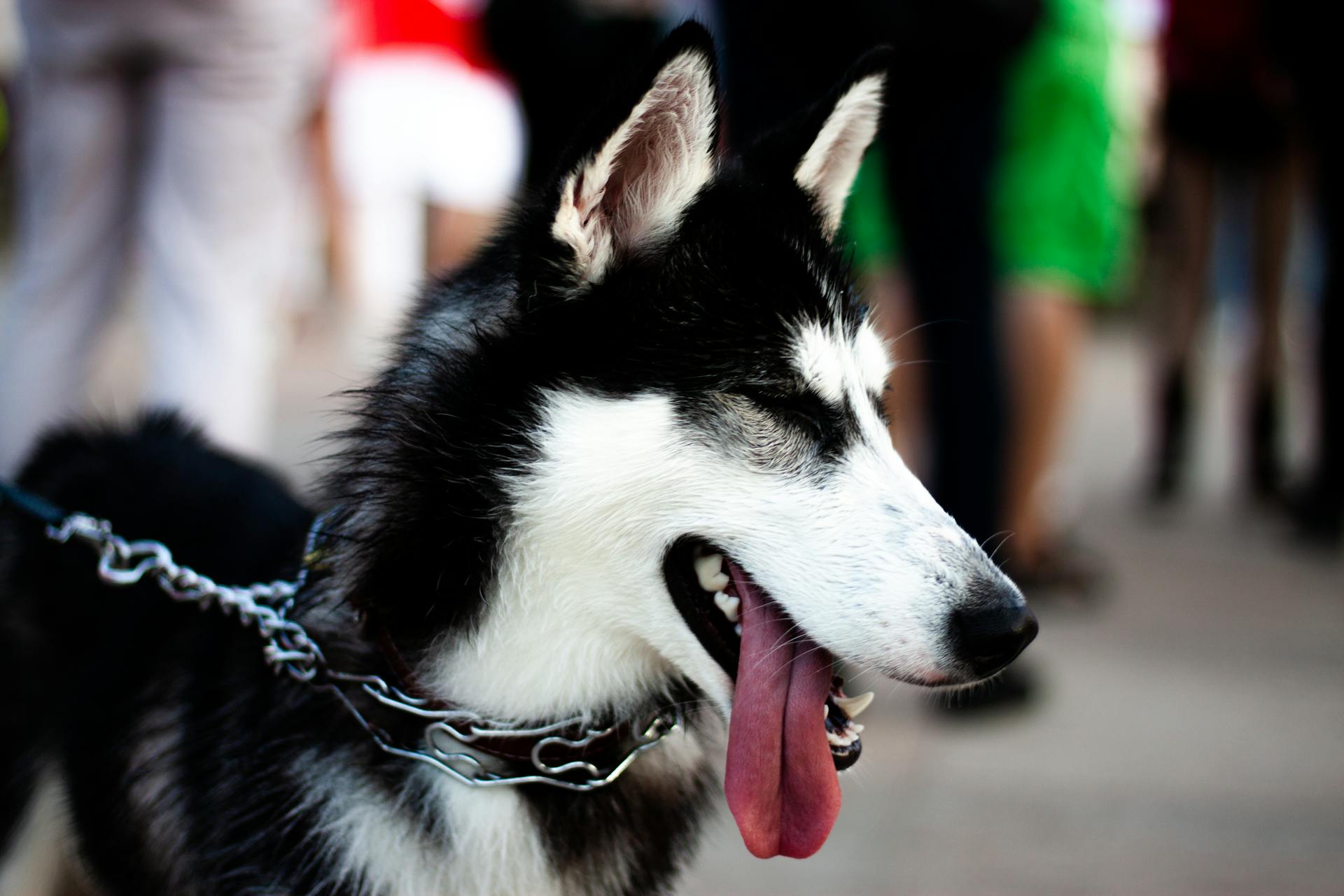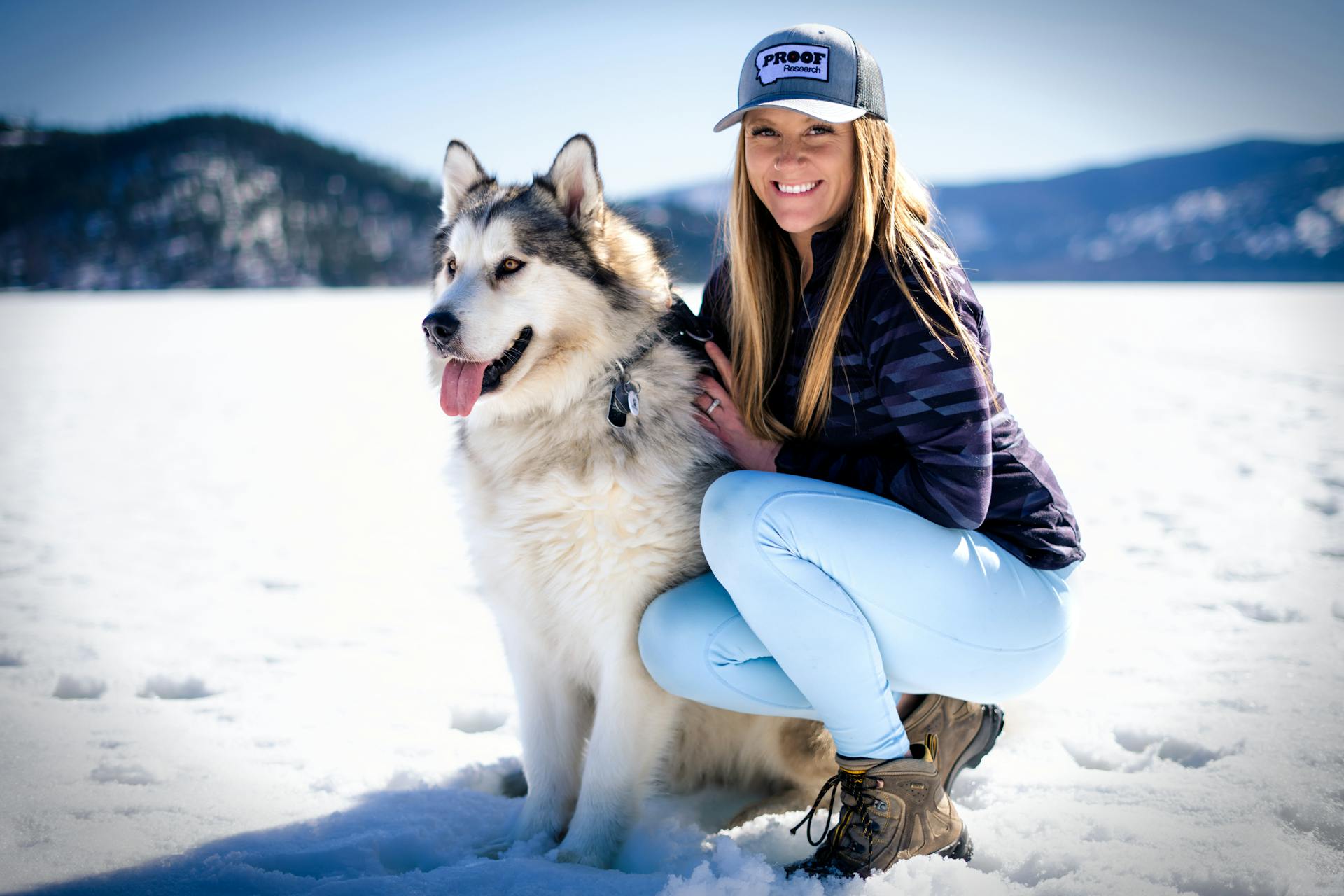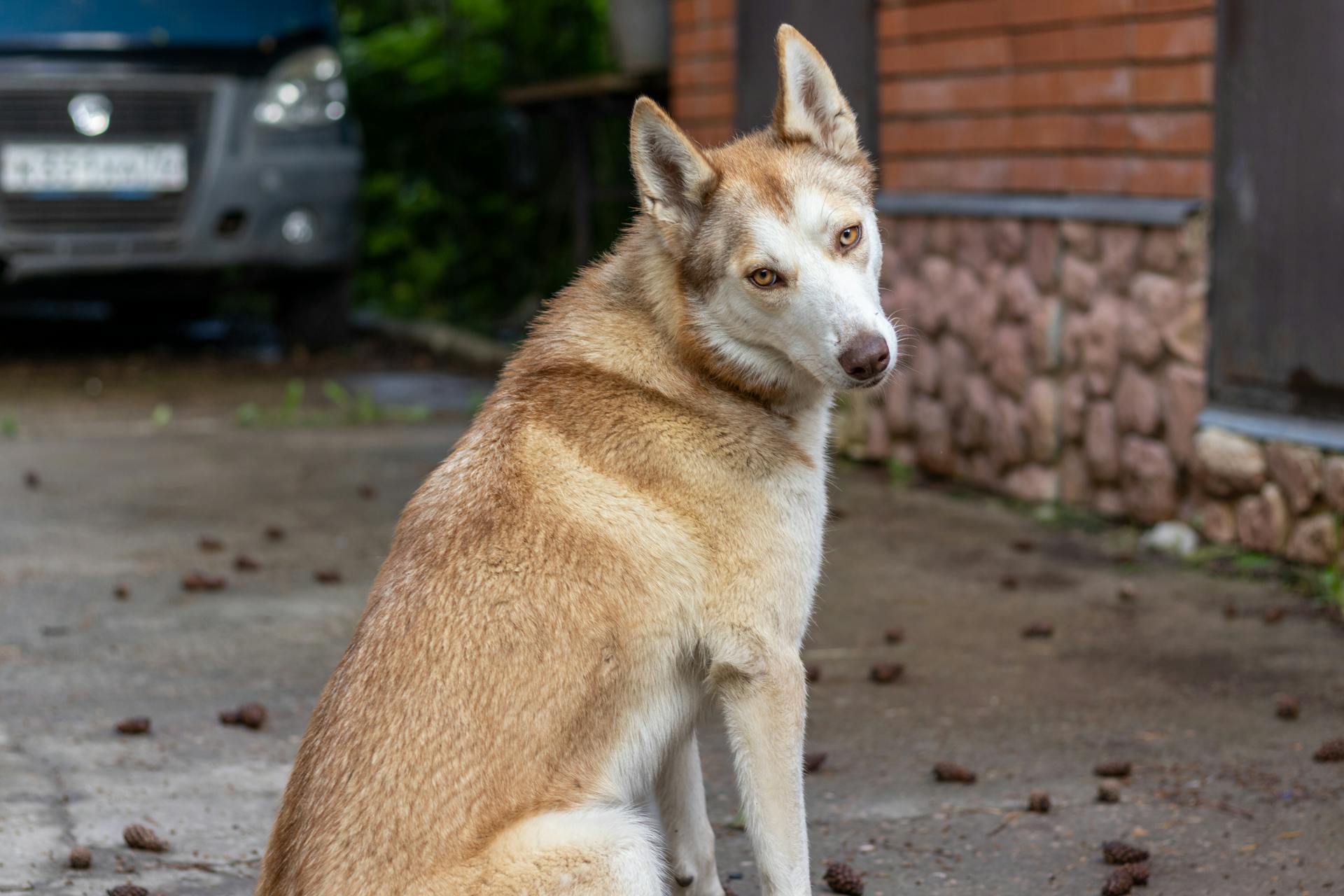
Husky dog females are a beloved breed, known for their striking blue or brown eyes and thick, double coats that keep them warm in freezing temperatures.
Husky females typically weigh between 35-60 pounds and stand between 20-22 inches tall at the shoulder.
They're a medium to large breed, requiring regular exercise to stay happy and healthy.
Husky females are highly intelligent and trainable, but can be strong-willed and independent, making consistent training and socialization a must.
How Big Will My Get?
If you're wondering how big your Siberian Husky will get, the answer depends on a few factors. Most Siberian Husky puppies will need at least 15 months to finish growing and filling out their chests.
At six months old, a male Siberian Husky will weigh around 30 to 40 pounds, while their female counterpart will weigh slightly less, approximately 25 to 33 pounds.
Your Siberian Husky puppy's growth rate can also be influenced by their genetics. If you purchased your puppy from a breeder, you could reach out to them about your puppy's estimated adult weight and height.
You might like: Will Spaying Calm a Female Dog
To estimate how much bigger your Siberian Husky will get, you can also take a look at their paws. While not a perfect science, paws that look oversized next to your puppy's body can indicate that your puppy is still growing and filling out.
Here's a rough estimate of your Siberian Husky's adult size:
Siberian Huskies are considered full-grown around their first birthday, but may need a few more months to finish filling out their chests.
Health and Care
Your female husky dog is a bundle of energy and joy, but like all breeds, she's prone to certain health issues. Siberian Huskies are generally hearty and healthy, but they can be at risk for genetic health problems.
To keep your husky healthy and happy, routine veterinary care is crucial. Regular check-ups with your vet can help prevent and minimize future health problems. This is especially important for purebred dogs like huskies, who are more likely to inherit genetic health issues.
For more insights, see: Problems with Husky Dogs
Some potential health issues to watch out for in your female husky include ocular issues, such as cataracts and glaucoma. These can be treated with surgery or medication, but it's essential to catch them early.
Von Willebrand Disease (vWD) is another potential issue, which can cause prolonged bleeding after injuries or surgery. Your vet can screen your dog for this disorder, and some dogs may need a blood transfusion with routine surgery.
Hip dysplasia is a common issue in huskies, causing limping, pain, and difficulty jumping. Weight management, joint supplements, and medication can help alleviate symptoms.
Autoimmune skin disease, such as pemphigus foliaceus, can cause hair loss, crusts, and infections. Treatment typically involves immunosuppressive medications, steroids, and antibiotics.
Epilepsy is another potential issue, which can cause seizures. Medications can help manage seizures, but it's essential to work closely with your vet to find the right treatment plan.
Hypothyroidism, an endocrine disorder, can cause weight gain, hair loss, and lethargy. Diagnosis is via blood test, and treatment often involves daily medication.
To keep your husky's coat healthy, regular brushing is essential. A zinc-responsive-dermatosis, common in huskies, can cause itchy, dry coats, stunted growth, diarrhea, and increased infections. A change in diet and added zinc supplementation can help treat this condition.
Broaden your view: Kerry Blue Terrier Short Hair
Here are some key health issues to watch out for in your female husky, along with their typical age of onset:
By being aware of these potential health issues, you can take steps to prevent and treat them, ensuring your female husky lives a happy and healthy life. Regular veterinary care, a healthy lifestyle, and a commitment to providing the best possible care can make all the difference.
On a similar theme: How to Care for Female Dog after Spay
Temperament and Training
Huskies are known for their friendly and intelligent nature, making them wonderful companions. They thrive on social interaction and love spending time with their owners, which is essential for their emotional well-being.
A Husky's strong prey drive means they may chase wildlife or other small animals, so it's crucial to keep them on a leash or in a secure area when outdoors. They also have a tendency to escape if they sense an opportunity, so secure fencing is a must.
A unique perspective: Female Dog Frequent Urination
Huskies are strong-willed, which can make training a challenge, but early training is vital for their development. Introducing basic commands and leash manners from an early age will help them become a well-behaved family member. Consistent, structured training sessions with clear goals and rewards will help you establish a strong bond with your Husky.
Here are some key traits to keep in mind when training your Husky:
- Early training is essential for their development.
- Consistent, structured training sessions with clear goals and rewards are crucial.
- They thrive on having a purpose and being engaged, so make sure to keep them active and stimulated.
Temperament & Personality
Siberian Huskies are known for their friendly and intelligent nature, making them wonderful companions who thrive on social interaction. They have a strong instinct to be surrounded by both humans and fellow canines.
Huskies are predisposed to welcoming strangers, which means they lack the traits of a typical guard dog. This is not a problem if you don't need a guard dog, but it does require you to be mindful of your home's security.
A key aspect of a Husky's personality is their strong prey drive, which means they may chase cats and small animals. With consistent training and socialization, they can learn to coexist with other pets.
A different take: Female Guard Dog Names
Huskies are also notorious for their escape attempts, especially if left in the backyard without secure fencing. This is because they have a strong instinct to explore and may try to escape if they sense an opportunity.
Huskies are best suited to people with active lifestyles and who spend a lot of time outdoors. They love to explore and have a high energy level, so they need plenty of exercise and mental stimulation.
Here are some key characteristics of a Husky's temperament:
- They crave company and love spending time with their owners.
- They have a great sense of humor and enjoy playing and being playful.
- They can be independent and mischievous at times.
- They have a strong prey drive and may chase wildlife or other small animals.
- They are vocal and may howl or bark for attention.
Running Speed
A Siberian Husky can reach top speeds of up to 30 miles per hour.
Their impressive speed is matched by their stamina, allowing them to run up to 150 miles a day.
They can maintain an average speed of 9 to 10 miles per hour over long distances.
This energy and endurance make them well-suited for activities that require sustained running.
Grooming and Nutrition
Grooming a husky dog female requires regular attention to keep her coat in tip-top condition. Brushing her 2 or 3 times a week is recommended to remove shed or loose hair.
Her double coat sheds a lot during the spring and autumn, so extra care and more brushing will be needed during moulting season. This is known as 'blowing coat'.
To minimize shedding, brush her with a pin brush three to five times a week, and help loosen fur during high shedding seasons by using an undercoat rake every day.
A table summarizing grooming needs:
In terms of nutrition, a husky dog female needs around 1,000 calories each day, split over two meals, depending on her activity level. Be careful with cereals such as wheat, which can be hard for her to digest.
Nutrition
Nutrition is a crucial aspect of your Siberian Husky's overall health and well-being. A Husky's diet is relatively simple, requiring a moderate amount of food due to their naturally slow metabolism.
Adult Huskies typically need around 1,000 calories each day, split over two meals, depending on their activity level. This means that they can thrive on a balanced and nutritious diet without overeating.
A unique perspective: Dog Names Female Start with S
Be mindful of the ingredients in your dog's food, as some Huskies can find cereals like wheat difficult to digest. A high-quality commercial dog food is a great option, as it's designed to meet your Husky's specific needs.
Regular exercise is essential for Huskies, as it helps burn off energy and stimulate their appetite. This can be as simple as a daily walk or playtime in the yard.
To ensure your Husky stays hydrated, especially during hot summer months, make sure they have access to plenty of fresh water. This is crucial to prevent overheating and dehydration.
Here's a quick reference guide to Husky nutrition:
- Adult Huskies need around 1,000 calories per day, split over two meals.
- Be cautious of cereals like wheat, which can be hard for Huskies to digest.
- Regular exercise is essential for Huskies, as it helps burn off energy and stimulate their appetite.
- Provide plenty of fresh water, especially during hot summer months.
Grooming
Grooming is a crucial part of Husky ownership, and it's essential to get it right to keep your furry friend happy and healthy.
Brushing is a must, with 2-3 times a week recommended to remove shed or loose hair. This will help prevent matting and tangling.
Huskies are not hypoallergenic, and they tend to shed a lot during the spring and autumn – a process known as 'blowing coat'. This means extra care and more brushing will be needed during moulting season.
Related reading: When Can a Female Dog Get Pregnant during Heat
Brushing your Husky's teeth daily is also crucial for good dental hygiene. Once a year, take them to the vet for a professional cleaning to prevent periodontal disease.
Bathing your Husky should be done quarterly or every other month, unless they've gotten dirty or you live in warmer weather. Look for a dog shampoo that suits their individual needs.
Trimming your Husky's nails about four times a year is also important. Husky nails don't grow fast, but you'll know it's time when you hear a clickety-clack on hard surfaces.
Here's a quick guide to help you keep track of your Husky's grooming needs:
Appearance
The Siberian Husky's appearance is truly one of a kind. Their striking features are a testament to their endurance and working background.
Their ears are erect, triangular, and sit high on their head, giving them an attentive look. This unique ear shape helps them to stay alert and focused.
Their almond-shaped eyes can be blue or brown, and some Huskies even have one eye of each color, which is known as parti-eyed.
The Siberian Husky's nose is straight, well-defined, and neither pointed nor square, adding to their distinctive appearance. Depending on their coat color, their nose can be black, liver (brown), or even pink.
Their medium-length, double coat is a key feature of the breed, with long guard hairs on top and a soft, thick undercoat. This coat requires regular grooming to prevent matting and tangling.
Their coat colors are just as varied, with options including white, black, gray, sable, brown, red, and agouti (alternating black and tan bands on the hair shaft). Some Huskies even have a special wooly gene that produces a long, beautiful coat.
Their tail is thick with fur and resembles a fox tail, curving upwards when they're at attention and trailing when they're at rest.
You might like: Hungarian Vizsla Coats
History and Characteristics
The Siberian Husky is a breed with a rich history and unique characteristics. Originally bred in Siberia, they were used as working dogs to pull sleds and provide companionship to the Chukchi people.
A key aspect of the Siberian Husky's history is their ability to withstand harsh arctic conditions. They have a thick double coat that can survive temperatures well below -70°F. This coat also reflects heat in the summer, making them well-suited to a variety of climates.
The breed's athletic reputation is well-documented, with their participation in the 1925 serum run, a dog sled relay over 600 miles in less than six days to rush a lifesaving serum to Nome, Alaska. During this event, a Siberian Husky named Balto led the final stages of the journey and is now a celebrated hero.
The Siberian Husky is a medium-sized dog, with males weighing between 45 and 60 pounds and females weighing between 35 and 50 pounds. They typically stand between 20 and 24 inches tall, with males being slightly taller than females.
Here's an interesting read: Can a Female Dog Get Pregnant by Multiple Males
History

The Siberian Husky's history is a fascinating one. They were originally bred as working dogs in the Russian region of Siberia by the Chukchi people, indigenous Siberians.
These dogs were bred to provide companionship and work as sled dogs, hauling loads over miles of tundra in frigid temperatures. They enabled the Chukchi people to expand their hunting and gathering territories.
The Siberian Husky's significance extended beyond Siberia when folks seeking fortune brought the breed to Alaska to pull sleds during the Gold Rush era of the late 1800s and early 1900s. At this time, they also participated in sled-dog races alongside the Alaskan Malamute and Samoyed.
In 1925, a diphtheria epidemic hit Nome, Alaska, and a team of sled dogs, including a Siberian Husky named Balto, delivered a lifesaving serum to the town, covering 600 miles in less than six days. Balto was the lead dog on the final stages of the journey and is one of the most celebrated dogs of all time.
The Siberian Husky was recognized by the American Kennel Club (AKC) in 1930 and the Siberian Husky Club of America was formed shortly after in 1938. Today, the Siberian Husky is a popular family pet in America.
Modern Utilization

Siberian Huskies are still working as sled dogs today, just like they were bred for. They're a preferred breed for sled dog races, and you'll often see them participating in events like the Iditarod trail race in Alaska.
Their independent nature makes it hard to utilize them as service dogs. They can be stubborn during training, especially male Huskies.
Early training is crucial for Huskies, as they're pack dogs with a hierarchical order. They may challenge authority when trained, which is more common in males than females.
A Siberian Husky will thrive in snowy conditions, but they can adapt to any climate. In climates with little to no snow, providing plenty of exercise is essential to keep them busy and active.
Exercises like running, bikejoring, and hiking are great options, but be sure to provide plenty of water and do them in the early morning or late afternoon in summer to avoid overheating.
Breed Characteristics
Siberian Huskies are a medium-sized breed, with males weighing between 45 and 60 pounds and females weighing between 35 and 50 pounds.
Their height varies slightly by sex, with males standing at 21 to 24 inches tall and females reaching 20 to 22 inches.
One of the most distinctive features of Siberian Huskies is their incredibly thick double coat, which helps them withstand even the harshest arctic conditions.
This double coat also reflects heat in the summer, making it a vital adaptation to their environment.
Huskies are known for their unique vocalizations, which include howling, whining, and chirping, but rarely barking.
Their eyes are often blue, brown, or black, but some Huskies may have bicolor eyes, where each eye has a different color, a trait known as heterochromia.
This unique eye color doesn't affect the breed's vision, so it's purely a matter of aesthetics.
Check this out: Why Do Siberian Huskies Have Different Colored Eyes
Frequently Asked Questions
Are female Huskies calmer?
Female Huskies may not be inherently calmer than males, as temperament can vary greatly depending on individual personalities and owner preferences. Research suggests that male Huskies may be more outgoing and affectionate, but more information is needed to determine the best fit for your lifestyle.
How big does a female Husky get?
A female Siberian Husky typically stands between 20 and 22 inches tall and weighs between 35 and 50 pounds. This size range is ideal for a healthy and balanced female Husky.
Featured Images: pexels.com


